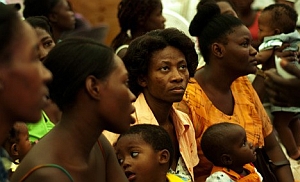Researchers at Karolinska Institutet in Stockholm, Sweden used data from a mobile phone company in Haiti to devise a system to predict population displacements when disaster strikes. Their findings appear online in in the journal Proceedings of the National Academy of Sciences (paid subscription required), and formed the basis of a service to help relief organizations working in disaster areas.
Researchers Linus Bengtsson and Xin Lu, doctoral students in Karolinska Institutet’s Division of Global Health, analyzed the movements of 1.9 million mobile phone users during the period from 42 days before, to nearly a year (341 days) after the devastating Haiti earthquake of 12 January 2010. The data were provided by Digicel, the largest mobile phone operator in Haiti.
The extent of the damage of the earthquake, coupled with the disorder that ensued, suggests that people’s movements as a result of the quake would have been difficult to predict. Bengtsson and Lu found a lot of people in Haiti did indeed move as a result of the disaster; 19 days after the earthquake, population movements had caused the population of the capital Port-au-Prince to decrease by some 600,000 or 23 percent. However, the researchers found the predictability of people’s movements remained high, in spite of the disruptions.
While people moved greater distances after the earthquake compared to before, Bengtsson and Lu found that Haitian people’s daily movement patterns were quite regular. Knowing a person’s movements during the first three months after the earthquake, the researchers were able to predict with 85 per cent probability the location of this same person on a particular day in the ensuing period.
“When disaster strikes we tend to seek comfort in our nearest and dearest,” says Lu. “We can see by the mobile data that where people were over Christmas and New Year, which was just before the earthquake, tended to be the place where they returned to afterwards.”
Lu and Bengtsson are offering their methods of analyzing and predicting population movements in the wake of disasters to aid organizations, in the form of Flowminder.org, a not-for-profit organization they established. Flowminder.org aims to establish a global clearinghouse for aggregating, analyzing, and disseminating mobile phone location data to non-government organizations and relief agencies during disaster relief and reconstruction efforts.
Read more:
- Grant to Fund Research on Earthquakes, Building Design
- Ad Hoc Network Devised for Emergency Communications
- Recycled Haitian Concrete Found Safe, Strong
* * *


 RSS - Posts
RSS - Posts
Outstanding work.
Larry Roeder, Policy Adviser on Disaster Management, Retired, US Department of State